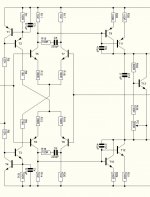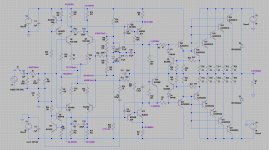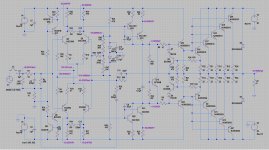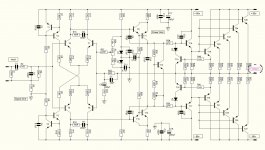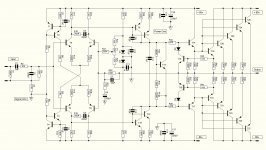Hi folks,
I'm working on another amp and have some decisions to make around the second stage. I could go the MJE340/350 (stand alone or darlington/ compound / cascode) but I like the idea of faster & more linear devices. Finding one that will take a bit of heat is difficult, hence my question; Is it ok to parallel them. In this example it is T9-T12 and I'm thinking 2 each of 2SA1381 & 2SC3503.
Naturally I will match them so I feel it's ok, but have I missed something?
Cheers
Q
I'm working on another amp and have some decisions to make around the second stage. I could go the MJE340/350 (stand alone or darlington/ compound / cascode) but I like the idea of faster & more linear devices. Finding one that will take a bit of heat is difficult, hence my question; Is it ok to parallel them. In this example it is T9-T12 and I'm thinking 2 each of 2SA1381 & 2SC3503.
Naturally I will match them so I feel it's ok, but have I missed something?
Cheers
Q
Attachments
Hi Quasi,
Looking at your circuit, your target is about 30mA as VAS bias current. I don't know what the rail voltages are, but suppose they are 50V; this means a power dissipation of 1,5W. This will remain offcourse, also with 2 devices in parallel.
Looking at the datasheet of the 1381/3503; Ft is max and you are in the lineair region of the transfer curve (Vbe/IC).
I would use 1 device with sufficiënt heatsinking.
But in using 2 pairs, I don't see a problem. IIRC the Titan 2000 from elektor uses parallel devices in the VAS, you should look it up.
BTW: have a look here, I think you can have problems with stable VAS currents.
HEEEELLLPPP : M. Randy Slone Mirror Image Topology Construction - Troubles
Looking at your circuit, your target is about 30mA as VAS bias current. I don't know what the rail voltages are, but suppose they are 50V; this means a power dissipation of 1,5W. This will remain offcourse, also with 2 devices in parallel.
Looking at the datasheet of the 1381/3503; Ft is max and you are in the lineair region of the transfer curve (Vbe/IC).
I would use 1 device with sufficiënt heatsinking.
But in using 2 pairs, I don't see a problem. IIRC the Titan 2000 from elektor uses parallel devices in the VAS, you should look it up.
BTW: have a look here, I think you can have problems with stable VAS currents.
HEEEELLLPPP : M. Randy Slone Mirror Image Topology Construction - Troubles
Thanks Bensen
I had a look at the Titan - 3 pairs and cascode!
My rails for this stage are +-85v and my target current is about what you suggest. So about 2.5 watts dissipation per side. I expect them to get quite warm even with a small heatsink so my reasoning for pairs.
I guess if its good enough for Giesberts then might be ok.
I had a look at the Titan - 3 pairs and cascode!
My rails for this stage are +-85v and my target current is about what you suggest. So about 2.5 watts dissipation per side. I expect them to get quite warm even with a small heatsink so my reasoning for pairs.
I guess if its good enough for Giesberts then might be ok.
have I missed something?
Maybe.
Putting so huge Miller cap (2x47pF) will greatly sacrifice slew rate for keeping amplifier stable.
Try to use external compensation and relatively small VAS current.
The goal is to lower reverse capacitance from the high-level point (VAS output) to the low-level point (IPS output).
It's better to use cascode there, it will remove that coupling by capacitive coupling cascode device base to ground.
Maybe.
Putting so huge Miller cap (2x47pF) will greatly sacrifice slew rate for keeping amplifier stable.
Try to use external compensation and relatively small VAS current.
The goal is to lower reverse capacitance from the high-level point (VAS output) to the low-level point (IPS output).
It's better to use cascode there, it will remove that coupling by capacitive coupling cascode device base to ground.
Small VAS current equals lower gain (higher VAS degen. or lower IPS collector resistors) = option to reduce Cmiller. But it depends on what the VAS has to drive, not known while no full circuit available.
Lowering reverse capacitance equals increasing Vcb, with a cascode you will have the contrary, not? With a cascode this capacitance is offcourse stable and not fluctuating with the VAS output swing.
Just thinking here...I’m definitely not in your level of experience BesPav.
Your supply rails are +-85v for this stage, so that you will build a high power amp.
For a high power amp, we usually have 3 more stages pre-driver, driver and final power output, therefore you mention this stage actually no need using too high driver current, a 7mA~10mA is quite enough for it.
For a high power amp, we usually have 3 more stages pre-driver, driver and final power output, therefore you mention this stage actually no need using too high driver current, a 7mA~10mA is quite enough for it.
Thanks BePav & Bensen. I will try to post the full schematic soon. Just drawing it up in spice.
Cheers & thanks for your suggestions.
Cheers & thanks for your suggestions.
Thanks Patrick. I plan to use split rails +-85v for this stage and +-80v for the output stage. Full schematic on the way.
100pF is a pretty standard value for a Miller compensation cap, certainly not in the "huge" category.
Thank you, will have a look at it. Linux user, I installed Texas TINA, no tube symbols included.
Now had a look at LTSpice but can not see how you would arrive at a nice schematic drawing like in post 1.
Now had a look at LTSpice but can not see how you would arrive at a nice schematic drawing like in post 1.
Hi as_audio
I hadn't finished the "nice" drawings when I replied earlier. Here they are comparing two different 2nd stage configs. Note; some of the component values are not finalised.
Cheers
Q
Attachments
Other members now post the LT Spice .asc file of their schematic. This can be zipped with any special parts models used and downloaded by readers and examined in their own LT Spice program, just like other files they may generate. A really amazing and useful time-saver.
Last edited:
Hi Ian, thanks for the advice.
I'm an LT Spice novice, can you please describe what I should send? I added some transistors to the "standard.bjt" library so should I send that as well (maybe renamed)?
So in this instance, is it just the .asc file and the lib?
Cheers
Q
I'm an LT Spice novice, can you please describe what I should send? I added some transistors to the "standard.bjt" library so should I send that as well (maybe renamed)?
So in this instance, is it just the .asc file and the lib?
Cheers
Q
Hi Q,
Nice to see you here....... it's been a long time, and we are all a few years older!
Good circuit, although not a quasi!
Questions:
1. Have you done the sims with and without the two CCSs for the input LTPs? Using a resistor there will decrease PSRR; but will it ruin the performance?
2. You'd put two transistors in series for the VAS. What do you think is the advantage, and which transistor will you choose?
Hugh
Nice to see you here....... it's been a long time, and we are all a few years older!
Good circuit, although not a quasi!
Questions:
1. Have you done the sims with and without the two CCSs for the input LTPs? Using a resistor there will decrease PSRR; but will it ruin the performance?
2. You'd put two transistors in series for the VAS. What do you think is the advantage, and which transistor will you choose?
Hugh
- Home
- Amplifiers
- Solid State
- Second Stage. Paralleling transistors ok?
